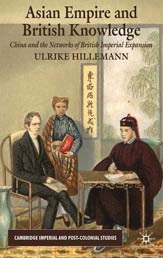
Editor-in-chief Trevor Harris
Book Review Editor Molly O'Brien Castro
![]()
Ulrike Hillemann, Asian Empire and British Knowledge: China and the Networks of British Imperial Expansion (Basingstoke: Palgrave Macmillan, 2009). £52.55 (hardback), 60,80€, 262 pages, ISBN 978-0-230-20046-3—Trevor Harris, Université François Rabelais, Tours.
The author’s intention is not to proceed from the European intellectual history perspective, but to “break up the old national narratives” [8]. Indeed, the principal focus of the study is not British domestic attitudes to China at all, but a study of the filiation and the circulation of ideas about China within the Asian empire itself, and between that empire and Britain. The author explores the British dealings with China from roughly 1760 to the outbreak of the first Opium War, and in particular the changing images of China in Britain, in relation to a number of institutional and cultural categories—law, language, religion, trade and views on the Chinese “race” and nation—by studying the Anglo-Chinese relationship as elaborated inside the principal “contact zones” between Britain and China: that is, Bengal, South-East Asia (especially Canton) and Britain itself, with the transfer there of (new) ideas about China during the Regency period and the Britain of the Reform Age...
The
author’s overall aim is to chart the demise of an ancien
régime vision of the East and the inaccessible, “mythical
Cathay” [175] and plot the subsequent emergence of a different
China: a country which was increasingly perceived, notably, as a legitimate
market to be opened up by free trade. Hillemann shows how, from the
early-modern period and up to the eighteenth century (when British
fashion and furniture were heavily influenced by “Chinoiserie”
and when many a building bore the Eastern imprint—the Kew pagoda
of 1762, for example, or the Brighton Pavilion begun in 1787), a lofty
vision of China gave way to one filtered through an emerging racial
discourse, and integrated into the debate between a declining mercantilism,
on the one hand, and the rising tide of liberal Britain on the other.
The development of the natural sciences was echoed by the growing
recognition of the “natural laws of trade” [176] which,
it was argued, would lead to, or at the very least contribute to,
the moral improvement of China.
Hillemann underlines the extent to which, as they became aware of
their own ignorance of China, British anxieties about the cultural
distance between the two peoples, and the apparently insurmountable
barriers—not least that of language and “the difficulty
and otherness of Chinese” [156]—were frequently palpable.
But, to be fair both to the British and to the author, so too was
the British capacity for nuance, for flexibility: in Hong Kong, after
the British took control, for example, it was decided [188] that Chinese
criminals, though tried in English courts, could be sentenced according
to Chinese laws... All British colonies were clearly not the same,
nor were they treated in the same way(s). The British engaged in genuine
dialogue and exchange, and often took a very real interest in the
territories they claimed to govern: it was rarely a matter of straightforward
imposition, and the British sometimes found themselves on the wrong
side of asymmetrical relationships.
Yet the fundamental respect for China which had prevailed in Britain until the middle of the eighteenth century—a positive impression based largely on the favourable accounts of China originally brought back by medieval travellers and Jesuit missionaries, and buttressed in Britain by a clear, “Tory” preference for the commercial status quo—was challenged by growing Whig/Liberal incursions, and by a middle-class, and therefore largely non-conformist, scrutiny of Chinese society and customs. Opinion on China was duly reshaped, and revised downwards: from a position of being perceived, up to the early nineteenth century, as lying on the very cusp of modern “civilisation,” the growing repatriation to Britain of knowledge about China caused a notable shift in attitudes. With the establishment of such organisations as the Royal Asiatic Society (1823), the Chinese increasingly became objects of study, and China a legitimate object of war and conquest, now incorporated into the remit of Britain’s global civilising mission. China, according to Hillemann, was now perceived as a stationary civilisation, a country where progress and development had come to a halt, and a territory which thus became ripe for development at British hands.
Indeed, as Hillemann shows, British relations with China were in many ways typical of Britain’s age of “improvement” and reform. Trade with China, though remaining concentrated through Canton, increased dramatically: tea imports into Britain, for example, rose from under 6 million pounds in 1783, to around 30 million pounds per year during the 1830s. Trading patterns, under the monopoly of the East India Company (mirrored by a “hong” monopoly on the Chinese side), were triangular between India, China and Britain. But the conditions in which that trade was done were to change in 1834 when the East India Company lost its monopoly and the Foreign Office took a more central role in Anglo-Chinese relations. Here economic history meets cultural history, and helps us to understand the evolution of the broader intellectual relationship between East and West which is the main focus of the book.
As we know from many sources, the emergence of an evangelical revival in Britain during the latter part of the eighteenth century was accompanied by the development of new middle-class sensibilities—the beginnings, as it were, of a new (conspicuous) consumerism. In order to supply the growing demand for tea, as well as luxury goods such as silk or porcelain, and in order to prevent a financially dangerous imbalance of trade, British merchants were drawn to develop, inter alia, the opium trade from India to China. That increasingly aggressive development was necessarily related to the changes taking place in the British view of China. The latter, in turn, was a complex process characterised not only by a metropolitan—i.e. Anglo-Scottish—discourse on the “meaning” of China, but also on a set of relationships functioning within Britain’s Asian and South-East Asian territories. British activity in China was, in very large part, conducted from India, which thus played a “metacolonial” role, and which also dictated that “Orientalism” in a British context was inevitably a set of attitudes bearing the imprint of both London/Edinburgh, on the one hand, and that of the network of “British” communities living and/or working in India and China. The “orientalisation” of China meant, above all, that it was inserted into a scale or hierarchy of civilisations issued from Enlightenment thinking: the point of reference for China became India, rather than ancient Greece or ancient Egypt [160]. China, that is, was vulnerable—like all territories in the formal or informal empire at that point—to an Enlightenment-inspired racial discourse; but also to the new “scientific” discourses on subjects as disparate as forms of government or linguistic development.
In the “Epilogue” [188-92], the author underlines that the “process by which the Chinese were assigned a specific position in the British world view was no simple one-way flow of ideas from the metropolis to the periphery.” This is undoubtedly true, as is the suggestion that there was never a “unifying ‘Orientalism’” [191], though even in Europe, surely, that Orientalism was not “unchallenged”? By contrast, claiming that from the late eighteenth century onwards, “the British have to be thought of as people, whose intellectual and cultural developments can only be understood in the context of its imperial expansion and the global spread of the British people” [189] is surely an exaggeration. Without shading too far back towards the opposite end of the scale—the argument which has sometimes been made that the British knew nothing of their empire, and were uninterested in the subject—the idea that the empire and diaspora are the only context in which Britain’s changing national self-image can be understood is probably excessive. If nothing else, in the late eighteenth and early nineteenth centuries, much of Britain’s intellectual and cultural development was defined by opposition to, and fear of, revolutionary and then Napoleonic France. As Hillemann herself points out national rivalries within Europe counted for a great deal, not least between “the eternal rivals France and Britain” [159]. Although there was an important imperial dimension to this, it was unlikely to be channelled through what was happening, say, in the Cape, as Britain took control of the province to prevent any possibility of a French initiative. In Britain itself, much of the population would have perceived the French and “Boney” as an immediate threat, looming just a few miles away on the other side of the Channel. There are, that is, limits to the extent and the penetration of the “networks” of empire, and the domestic dimension cannot be completely marginalised.
This
book is presented as a “study of knowledge formation”
and of the networks, or the “system of British interest in the
East” [1], and the author does a very good job of showing how
the new China replaces the old and, with a good quarter of the book
given over to the notes and bibliography, this is a thoroughly documented
and often fascinating survey of that country during the British Industrial
Revolution, and the evolution of its place in Britain’s national
imaginaire.
.
© 2013 Trevor Harris & GRAAT
Senior
sub-editor: Hélène Tison
lntison@yahoo.fr
Webmaster Georges-Claude Guilbert

